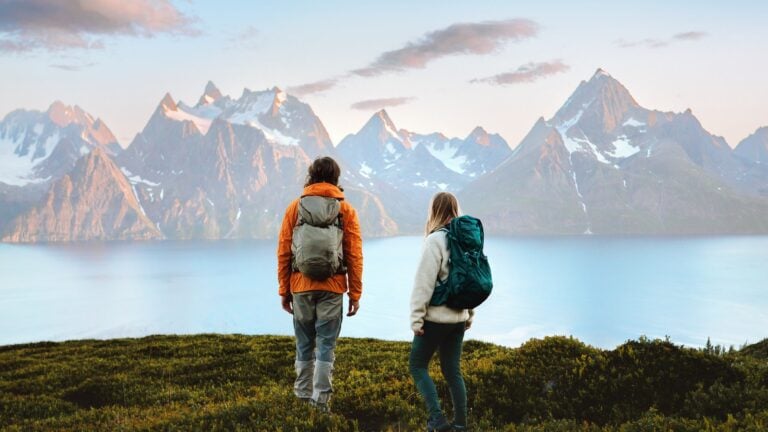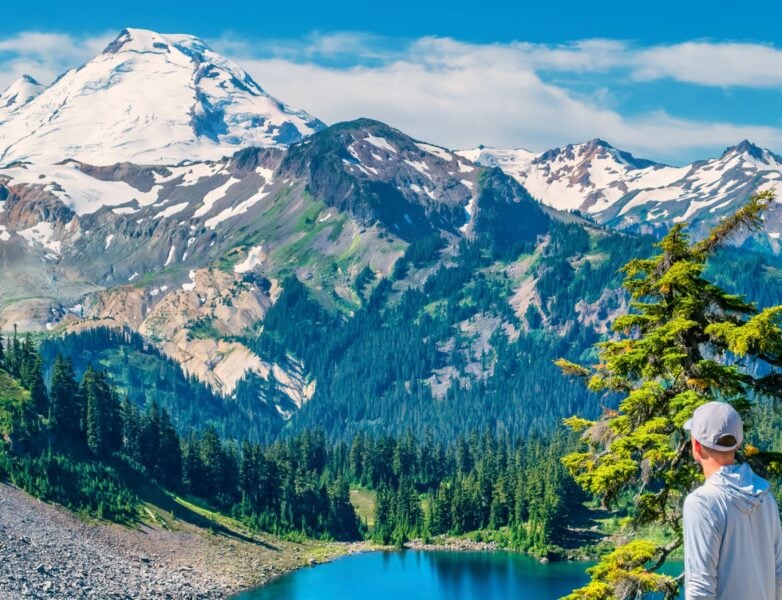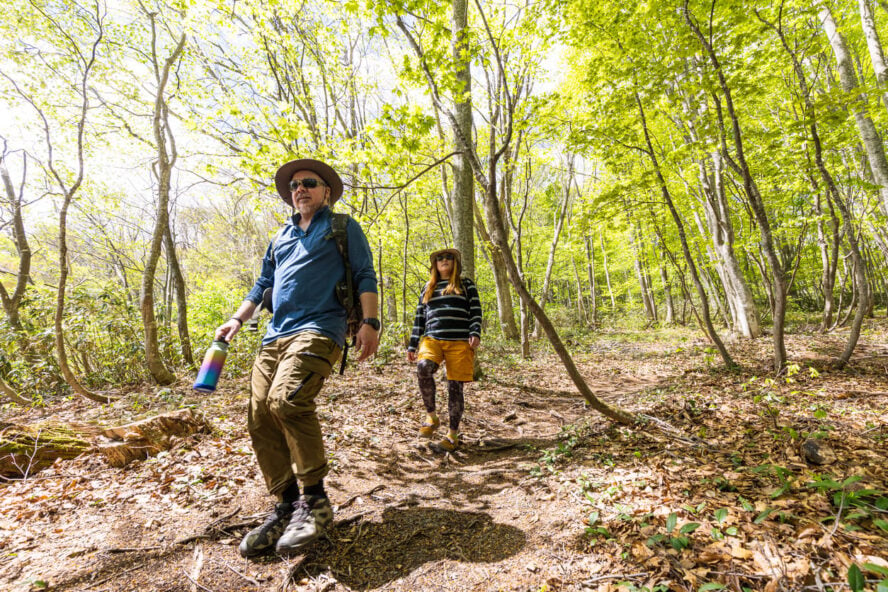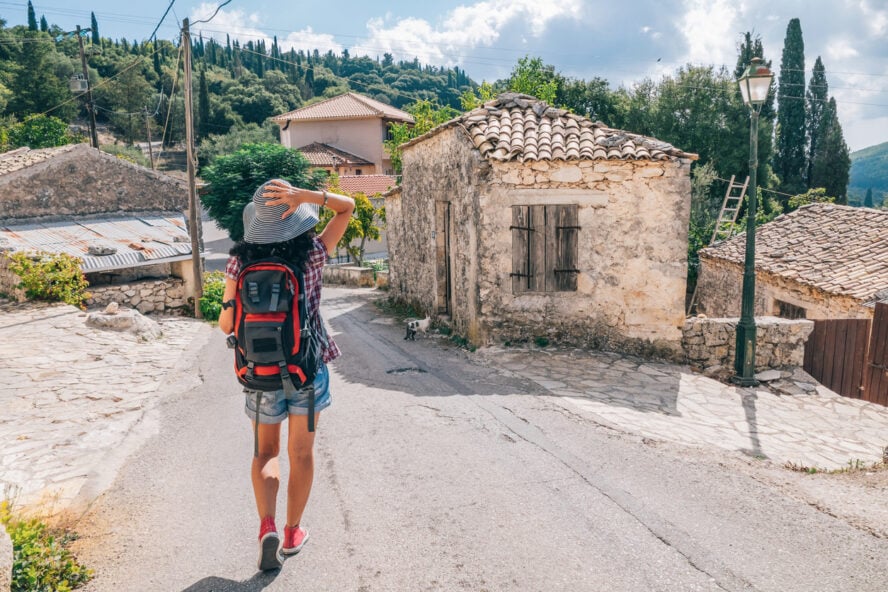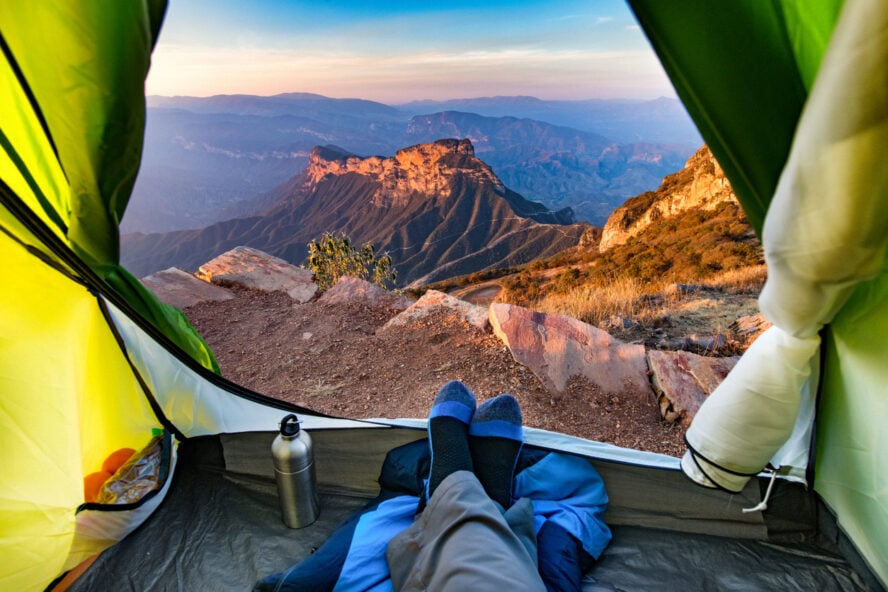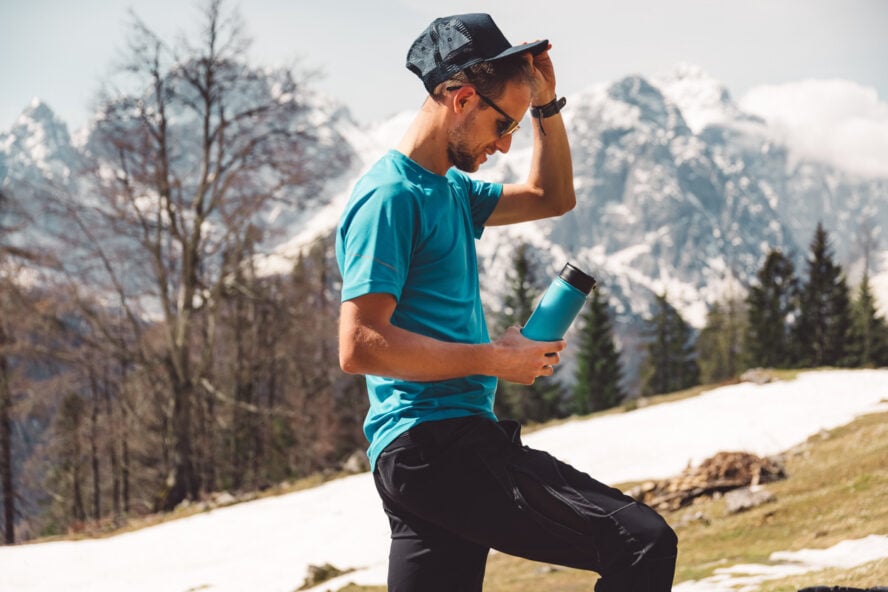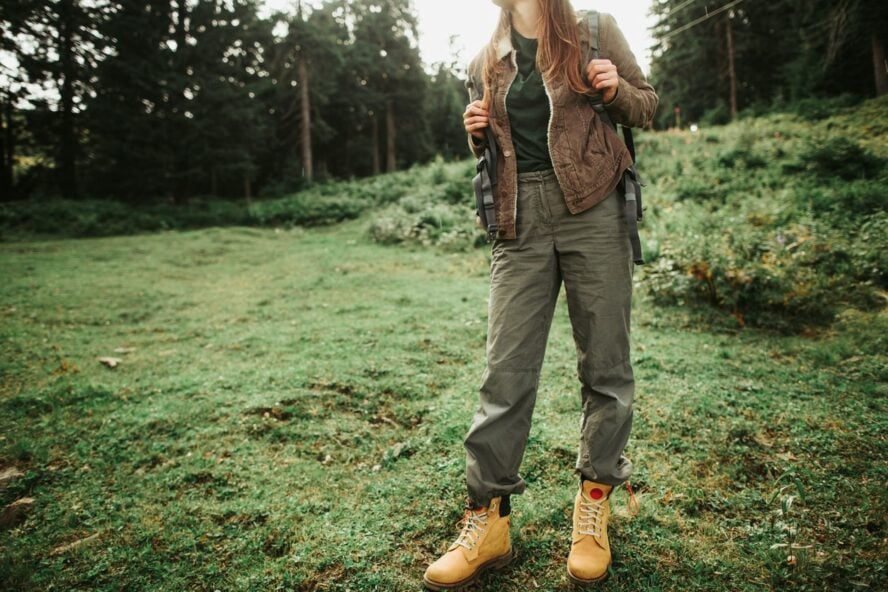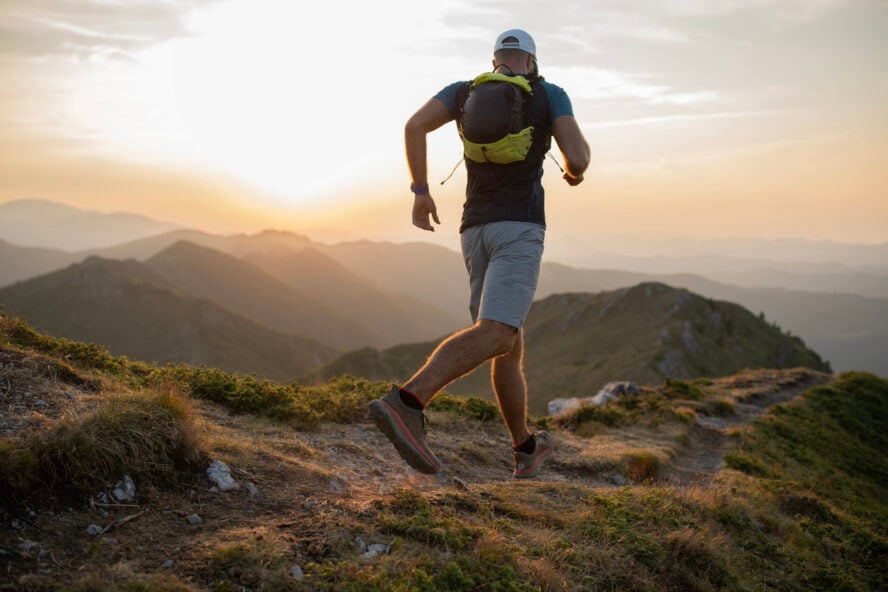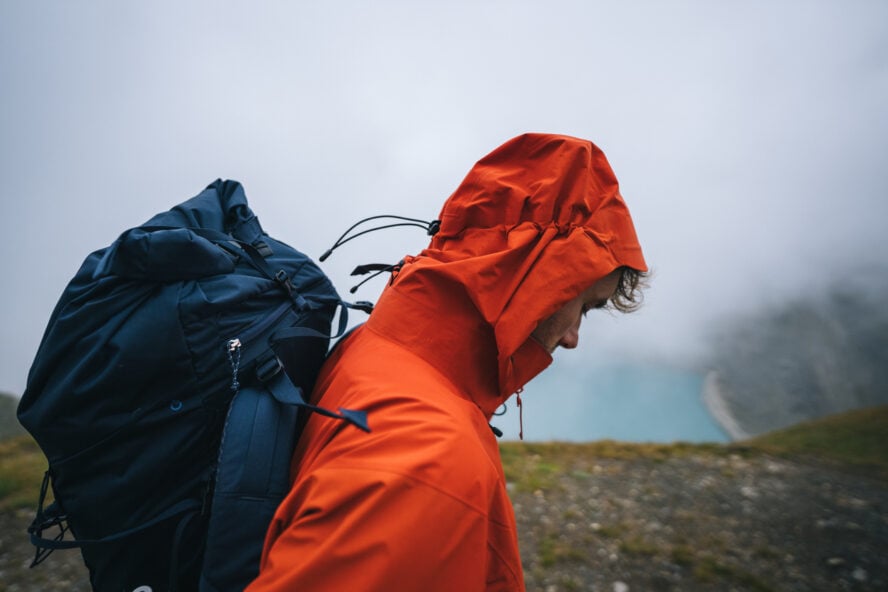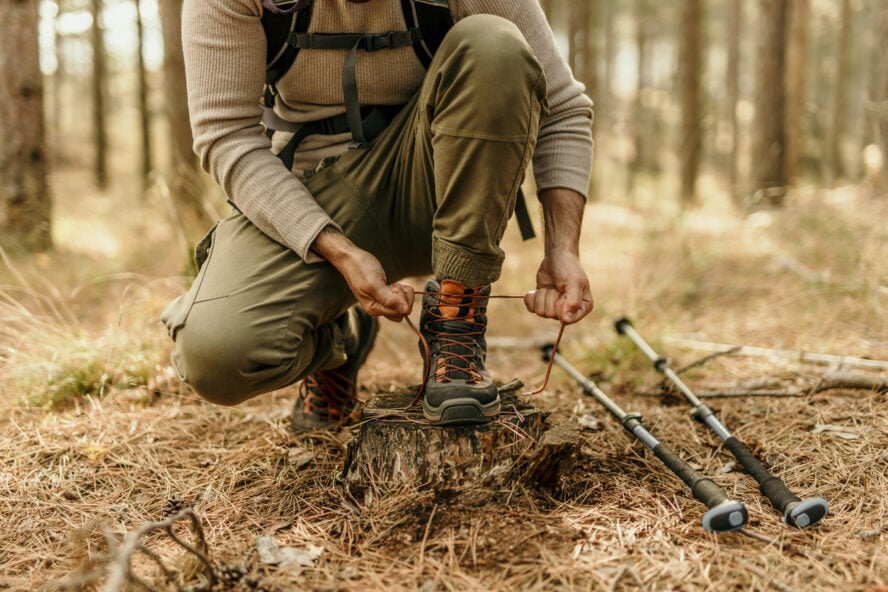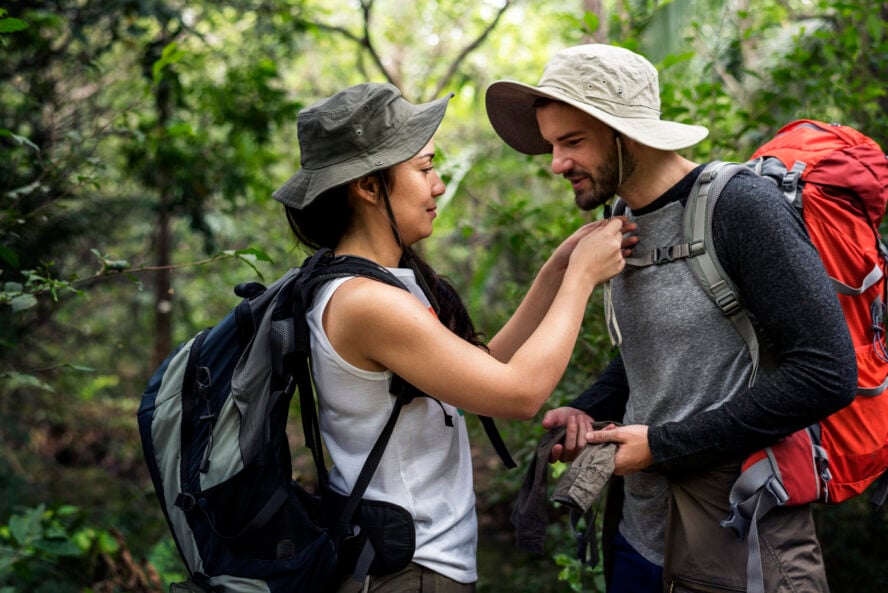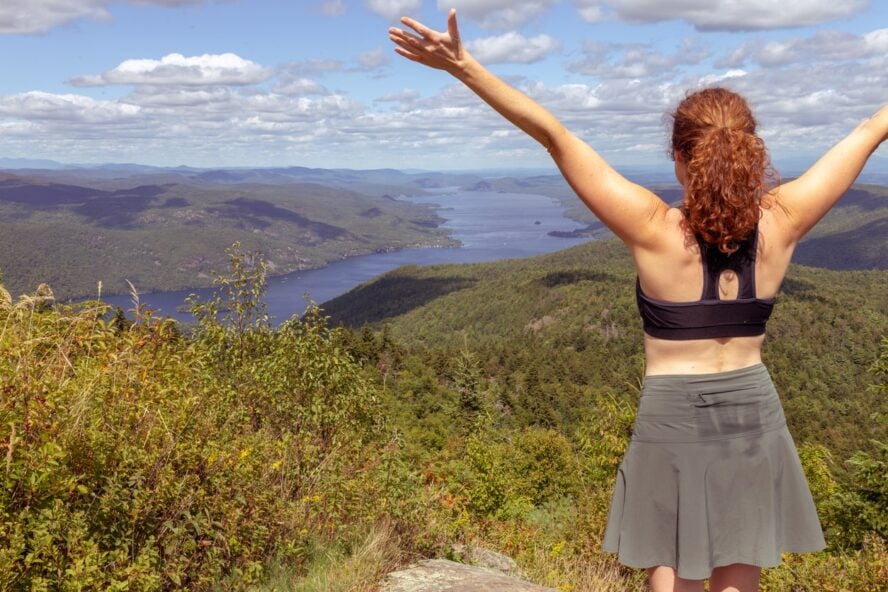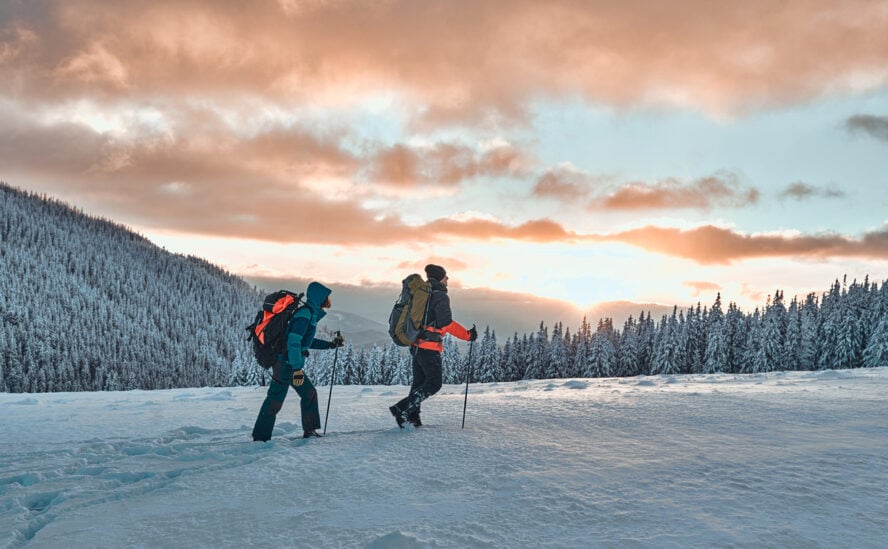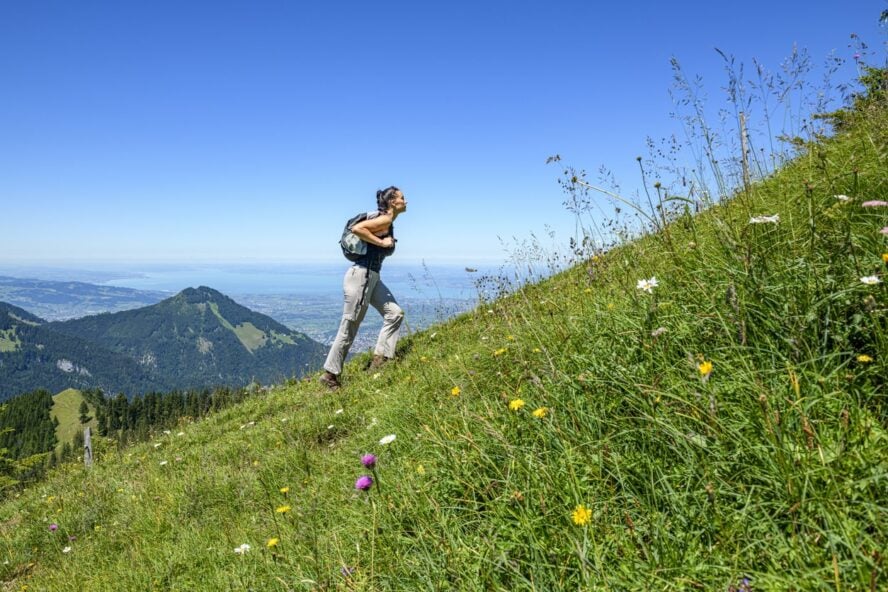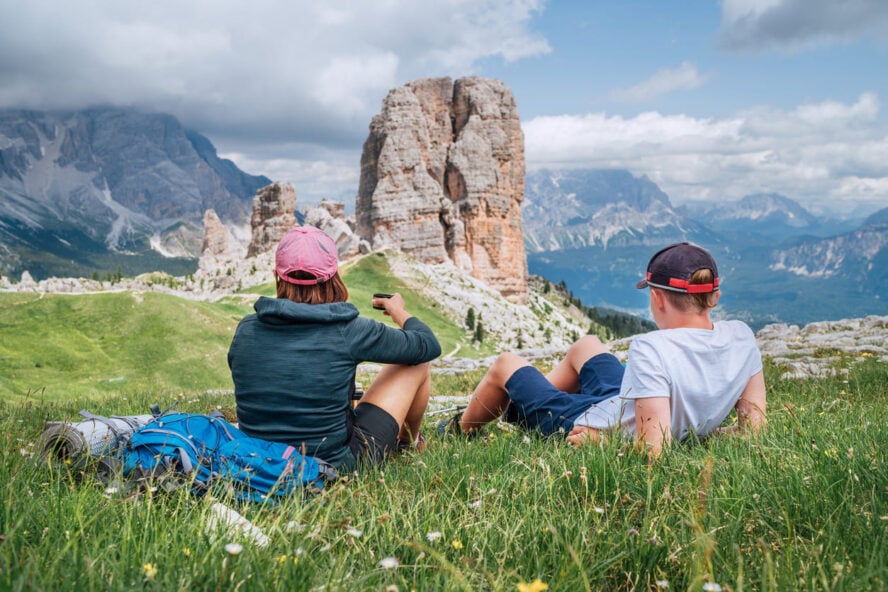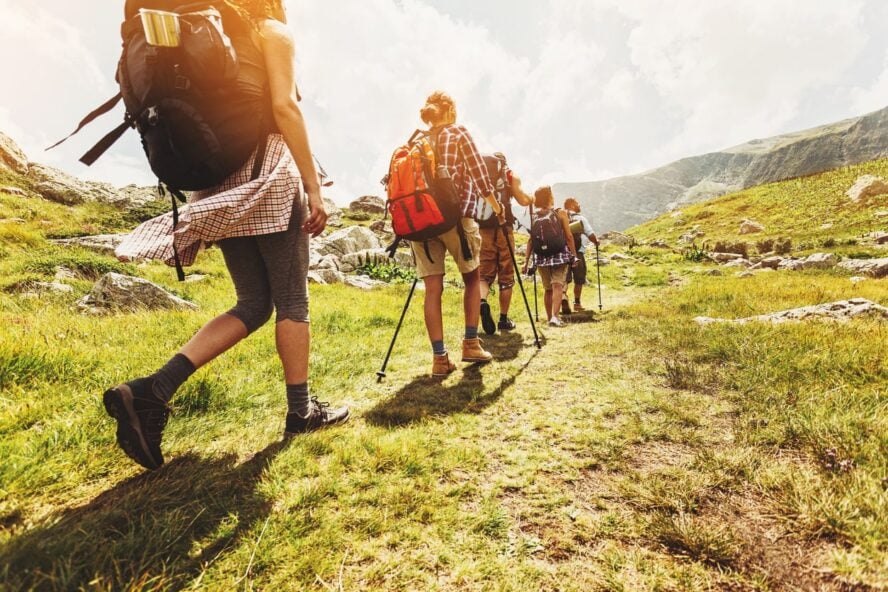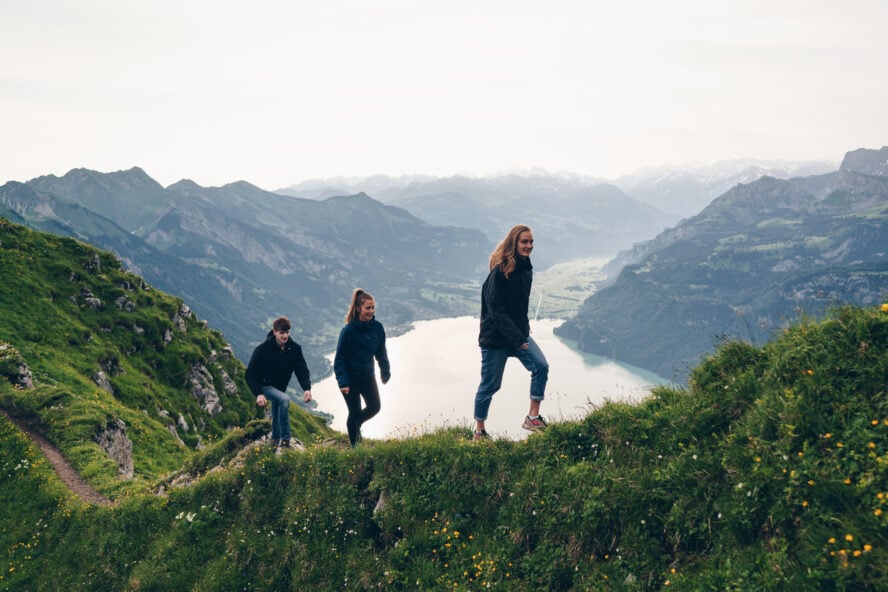When you picture the perfect day on the trail, you probably imagine sweeping views, crisp mountain air, and the rhythmic crunch of boots on dirt. But what you wear hiking can determine whether that day ends in awe or agony.
Hiking is as much about preparation as it is about passion, and the right clothing makes the difference between feeling free and feeling miserable.
Ever been soaked to the skin halfway up a ridge or blistered before lunch? IF so, you already know: comfort in the outdoors comes down to smart layering and technical fabrics, not fashion. Good hiking clothes work with the body and the environment. They breathe when you sweat, insulate when you cool down, and protect when the sky turns moody.
This guide is for anyone who wants to hike smarter, lighter, and more comfortably. Packing for a hike in the Dolomites, a journey across Iceland, or your first local trail? You’ll learn exactly what to wear, why it matters, and how to adapt for every condition nature can throw at you.
What to Wear Hiking? It Depends on Where You’re Going
If there’s one rule to remember, it’s that hiking clothing isn’t one-size-fits-all. What you wear depends entirely on where and when you’re hiking.
A coastal trail in Portugal has completely different needs from a glacier trek in Switzerland or a desert scramble in Utah. Climate, terrain, and weather patterns all dictate your ideal outfit. The key is versatility, the ability to layer up or down as conditions shift.
At its simplest, a solid hiking wardrobe follows the layering system:
-
Base layer: Keeps your skin dry by wicking sweat.
-
Mid-layer: Traps heat to regulate body temperature.
-
Outer layer: Protects against wind, rain, and snow.
This system works year-round, rainforest to ridge. It lets you peel off when climbing under the sun and bundle up when the wind turns cold. The goal isn’t perfection, but adaptability.
A lightweight fleece, for example, can be worn alone on a breezy summer morning or under a hardshell jacket in alpine conditions. The same principle applies to socks, pants, and even gloves.
The more versatile your gear, the fewer excuses you’ll have to stay home.
Understanding the Layering System
Before diving into individual pieces, let’s see how the layering system actually works in the real world.
Your base layer is your first defense against moisture. It pulls sweat away from your skin to prevent chills and clamminess. For most hikers, merino wool or synthetic tops do the job perfectly.
Your mid-layer provides insulation. It’s usually a lightweight fleece, down sweater, or synthetic puffy jacket — something that traps warm air close to your body without suffocating you.
Finally, your outer shell acts as your weather armor. It blocks wind, rain, and snow while releasing heat and moisture. A good shell can be the difference between a rough adventure and a dangerous one.
If you’re hiking somewhere humid and warm, your mid-layer may never come out of your pack. In alpine or shoulder seasons, you’ll rotate layers constantly: a shell for rain, fleece for shade, and a base layer when the sun finally breaks through.
Hiking Socks
What Are Hiking Socks?
Socks are often overlooked, but any experienced hiker will tell you they’re the foundation of comfort. Hiking socks are purpose-built to manage sweat, cushion your feet, and prevent blisters. They’re usually made from merino wool or synthetic fibers that wick moisture and insulate even when damp.
The best socks have reinforced heels and toes for durability, compression panels for support, and flat seams that won’t rub against your skin inside your boots.
Are Hiking Socks Necessary?
In a word, yes. Regular cotton socks trap moisture, which creates friction and blister hotspots. Once your feet start to blister, there’s no turning back. Every step becomes a test of endurance. Hiking socks eliminate that problem by keeping your feet dry, supported, and temperature-regulated.
What Kind of Socks Do You Want for Hiking?
Match your socks to the environment. In warm climates, go for lightweight or midweight merino socks. For cold-weather or alpine routes, thicker wool or synthetic options will give you extra warmth.
Some hikers swear by liner socks, which are thin under-socks designed to wick sweat and minimize rubbing. They’re especially useful on long-distance hikes where foot care is more critical.
Best Socks to Prevent Blisters
Merino socks from reputable brands like Darn Tough, Smartwool, or Icebreaker are practically blister insurance. They can stay snug, manage sweat, and resist odor even after several days on the trail. Combine them with well-fitted boots and breathable insoles, and your feet will carry you for miles without complaint.
Hiking Shirts
What Shirt Is Best for Hiking?
A good hiking shirt should keep you comfortable, cool, and dry. Skip cotton entirely, as once it gets wet, it stays wet. Instead, go for synthetic or merino wool shirts that wick sweat and dry fast.
Go for button-up hiking shirts for more ventilation and protection from the sun and bugs, or choose technical T-shirts, which are lighter and great for active trails.
What T-Shirt Is Best for Hiking in Hot Weather?
In the heat, airflow is your best friend. Look for shirts made from polyester or nylon blends with built-in UV protection and ventilated panels. Many modern hiking tees also include anti-chafe seams and quick-dry finishes.
Loose fits help air circulate better. Light colors reflect sunlight. A lightweight long-sleeve shirt can actually keep you cooler by shielding you from direct rays.
What Hiking Shirt Doesn’t Smell After Long Use?
For multi-day hiking adventures, merino wool remains the gold standard. It naturally resists odor thanks to lanolin, a waxy compound that prevents bacterial buildup. You can wear a merino shirt for days without washing it, and it’ll still feel fresh.
What makes synthetics not goot to wear hiking? They dry faster but tend to retain smells after repeated use. Might be a fair trade-off for shorter hikes or more humid regions.
What Pants to Wear Hiking
What Are Hiking Pants?
Hiking pants are your trail armor: tough, flexible, and designed to handle both movement and abrasion. They’re usually made from quick-drying synthetic fabrics with a bit of stretch, so they won’t cling when wet or restrict your stride.
Unlike jeans or leggings, they breathe, move, and adapt to your body’s rhythm on the trail.
What Type of Pants Is Best for Hiking?
Here’s a simple cheat sheet:
- For hot climates, lightweight hiking pants or shorts are ideal.
- In variable weather, convertible pants that zip off at the knees are the best, as they can save you from overpacking.
- For alpine treks, softshell pants are the go-to. They can block wind while giving you plenty of warmth and flexibility.
- Winter hikes call for insulated or fleece-lined pants, which retain heat without overheating during harder climbs.
What Are Good Hiking Pants Made Of?
Look for nylon or polyester blends with spandex for stretch. Fabrics with a DWR coating help shed rain and resist stains. Avoid cotton, which absorbs water and dries slowly.
Many quality hiking pants include articulated knees and gusseted crotches for ease of movement, as well as reinforced cuffs for durability against rocks or crampons.
How Should Hiking Pants Fit?
Hiking pants should fit comfortably around your waist without digging into your skin or slipping under your pack belt. The knees should flex easily, and you should be able to squat or step uphill without pulling.
If your pants have belt loops or built-in adjustments, test them before the trip. Comfort and range of motion matter more than style.
How Long Should Hiking Pants Be?
Your pants should cover the top of your boots to block dust, bugs, and debris. If they’re too long, you’ll trip; too short, and you’ll end up with dirty socks.
Adjustable hems, zippers, or drawcords at the ankles are ideal for fine-tuning.
Hiking Shorts and Leggings
Not every trail calls for full-length pants. In warm or dry regions, hiking shorts are unbeatable for ventilation and freedom of movement. If you choose shorts, go for stretchy nylon or quick-dry materials that don’t chafe.
In colder climates or on high-output hikes, leggings or hiking tights have become increasingly popular, especially among women hikers. It’s easy to see why; they move with your body, fit comfortably under waterproof shells, and dry fast after rain.
Some hybrid models combine tights with durable panels to give you that extra bit of protection in rough terrain. It’s the perfect middle ground between comfort and performance.
Hiking Jacket
How Do I Choose a Hiking Jacket?
Your jacket should protect you from the elements without trapping heat. You should think of it as a mobile shelter. If you’re not hardcore enough to buy multiple hiking jackets (yet), invest in a single lightweight waterproof-breathable shell that fits comfortably over other layers.
If you hike in cold climates, pair your shell with an insulating mid-layer like a down or synthetic puffy. In dry, windy environments, a softshell jacket might be enough on its own.
What Makes a Good Hiking Jacket?
A great hiking jacket balances 3 things: protection, breathability, and packability. It should have sealed seams, adjustable hoods, and ventilation zips under the arms. The fabric should feel sturdy but not stiff.
You’ll also want a hem that sits below the hip belt. This is to prevent water from dripping inside your pants. Also, you need wrist cuffs that can cinch tight against rain.
What Is the Best Waterproof Hiking Jacket?
Gore-Tex and eVent remain the benchmarks for waterproofing and breathability. For most hikers, something like the Patagonia Torrentshell 3L offers excellent protection and sustainability at a fair price. For heavier alpine use, the Rab Kangri GTX or Arc’teryx Beta LT are expedition-ready favorites among our guides.
Whatever brand you choose, prioritize fit and ventilation over flashy features. A jacket that fits perfectly will outperform a high-end one that doesn’t.
Hiking Boots
How to Choose the Right Hiking Boots
Your boots are the link between you and the mountain. Choose them based on the terrain, season, and how much weight you’ll carry.
For short or moderate trails, trail shoes or low-cut boots will provide enough comfort and agility. On rocky or multi-day routes, go with mid-cut boots for the right balance of support and flexibility. For rugged, off-trail conditions, high-cut boots can maximize ankle protection and stability.
Try them on late in the day (when your feet are slightly swollen) and always wear your hiking socks while testing fit. Your toes should never hit the front of the boot, even when descending.
How to Break in Your Hiking Boots
Break in new hiking boots gradually. Wear them at home, then on short hikes before going for long routes. This helps the materials soften and mold to your feet.
Skipping this step is a rookie mistake that leads to painful blisters and sore arches. Give your boots time. It’s a partnership worth building.
How to Clean Your Hiking Boots
A little care goes a long way. Brush off mud after every hike, remove the insoles to air them out, and wash the boots occasionally with warm water and mild soap.
Avoid placing them near heaters or fires. High heat can crack the glue and leather. Once dry, apply a waterproofing treatment to extend their life.
How to Lace Hiking Boots
Lacing might sound simple, but small tweaks make a big difference. Use the heel lock technique to keep your foot in place on steep descents and the surgeon’s knot to maintain tension around the ankle.
Experiment with different patterns until you find what feels secure but not restrictive. Good lacing will eliminate rubbing and reduce fatigue.
Accessories: The Small Things That Matter
Hiking Gloves
Even in summer, gloves can save the day. They shield against sun, wind, and surprise temperature drops.
For most hikes, lightweight fleece or softshell gloves are ideal. In wet or snowy conditions, waterproof insulated gloves keep your hands functional and warm.
If you’re trekking through variable climates, pair a liner glove with a waterproof shell glove. It’s a combination that experienced mountaineers go for to maximize flexibility.
Hiking Hat
Your hat is your simplest form of climate control.
In hot weather, a wide-brimmed sun hat or neck-flap cap will protect you from UV exposure. In cooler environments, a beanie or fleece cap keeps your head warm when the temperature drops.
A neck gaiter or buff is an all-season favorite: it shields from dust, wind, or sun, and can double as a headband or scarf when needed.
Women’s Hiking Clothing Considerations
Women-specific hiking clothing is more than marketing. It’s about fit and function.
Women’s cuts allow greater range of motion at the hips and shoulders while reducing bulk in areas that can cause chafing.
Sports bras made from moisture-wicking, quick-drying fabric are essential. Avoid cotton, which traps sweat and causes irritation.
For pants and jackets, look for adjustable waists and articulated knees. Many brands like Arc’teryx, Fjällräven, and Patagonia now offer women’s lines designed for long-distance comfort and technical performance.
What to Wear Hiking in Cold Weather
Winter hiking is a different beast, so layering becomes even more crucial.
Your base layer should be mid- to heavyweight merino wool, topped with an insulating mid-layer like fleece or synthetic puffy.
Add a windproof hardshell on top and insulated pants or gaiters to keep snow out. Accessories like balaclavas, thick gloves, and waterproof boots complete the setup.
It might sound counterintuitive, but always avoid overdressing. Sweating in freezing temperatures can lead to rapid cooling once you stop moving.
What to Wear Hiking in Hot Weather
For desert or tropical hiking, breathability is the most important factor. Lightweight, long-sleeve shirts and pants will protect you from UV rays and biting insects. Loose fits allow airflow and reduce chafing.
A brimmed hat, sunglasses, and a UV-blocking shirt are must-haves. Choose synthetic fabrics that wick sweat and dry quickly. Cotton’s cooling effect works for short hikes, but not on multi-hour trips.
Sustainable Hiking Apparel: Choosing Gear That Lasts
Fast fashion doesn’t belong in the backcountry. Always go for high-quality pieces that last for years. You’re reducing waste and saving money over time.
Many outdoor brands now use recycled materials, bluesign®-approved fabrics, and PFAS-free waterproofing to minimize environmental impact. Patagonia, Vaude, and Rab lead the way in eco-conscious production.
Taking care of your gear — repairing, reproofing, and washing properly — is the most sustainable choice you can make as a hiker.
What to Wear Hiking? Dress for Adventure, Not for Show
When choosing what to wear while hiking, don’t think about looking the part. Think about feeling ready for whatever lies ahead.
It’s the pair of socks that never give you blisters, the jacket that shrugs off rain, the boots that feel like an extension of your feet.
When you dress intentionally, hiking stops being a struggle and becomes a flow. Every movement is efficient, every layer invisible. You’re no longer thinking about what you’re wearing; you’re thinking about the trail ahead, the sound of the wind, the smell of pine, and the next horizon.
So build your kit wisely. Treat your clothes as tools, not accessories. Then get out there, because the best outfit for hiking is the one that lets you forget about it entirely.

